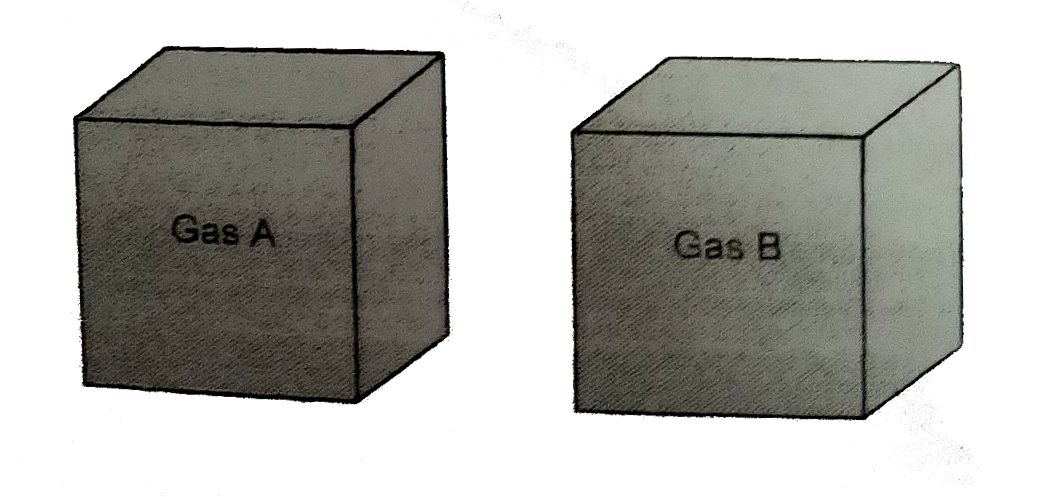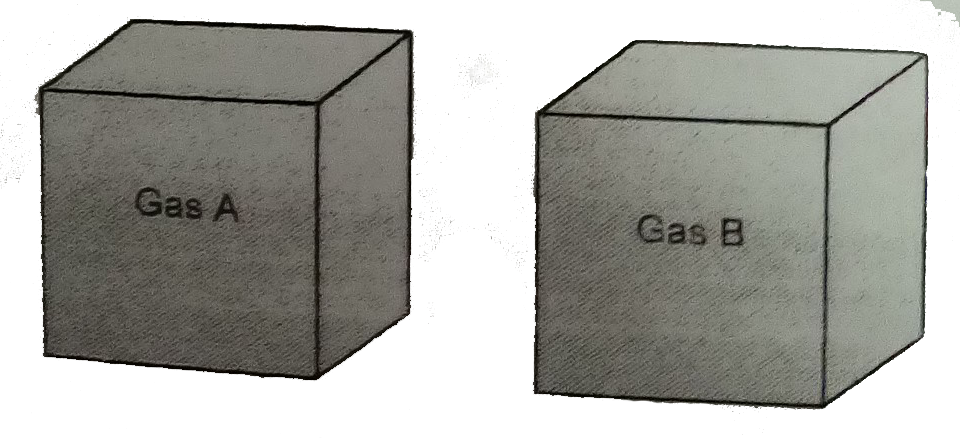Complete Solutions to PART -IV of chapter KTG & THERMODYNAMICS of Class 11 book with complete answers and questions
| Class 11 | PHYSICS |
| Chapter | KTG & THERMODYNAMICS |
| RESONANCE | PART -IV |
| Number Of Questions | 9 |
| Academic Year | 2023-24 |
Comprehension-1
Two closed identical conducting containers are found in the laboratory of an old scientist. For the vertification of the gas some experiments are performed on the two boxes and the results are noted.

Experimenet 1.
When the two containers are weighed `W_(A) = 225tg, W_(B) = 160 g` and mass of evacuated container `W_(C) = 100g`.
Experiment 2.
When the two containers are given same amount of heat same temperature rise is recorded. The pressure changes found are
`DeltaP_(A) = 2.5 atm, Deltap_(B) = 1.5 atm`.
Required data for unknown gas:
`|(underset("molar mass")(Mono)",He,Ne,Ar,Kr,Xe,Rd),(,4g,20g,40g,84g,131g,222g),(underset(molar mass)(Dia),H_(2),F_(2),N_(2),O_(2),CI_(2),),(,2g,19g,28g,32g,71g,)|`
Total number of molecules in 'A' (here `N_(A) =` Avagadro number)
View SolutionComprehension-1
Two closed identical conducting containers are found in the laboratory of an old scientist. For the vertification of the gas some experiments are performed on the two boxes and the results are noted.

Experimenet 1.
When the two containers are weighed `W_(A) = 225tg, W_(B) = 160 g` and mass of evacuated container `W_(C) = 100g`.
Experiment 2.
When the two containers are given same amount of heat same temperature rise is recorded. The pressure changes found are
`DeltaP_(A) = 2.5 atm, Deltap_(B) = 1.5 atm`.
Required data for unknown gas:
`|(underset("molar mass")(Mono)",He,Ne,Ar,Kr,Xe,Rd),(,4g,20g,40g,84g,131g,222g),(underset(molar mass)(Dia),H_(2),F_(2),N_(2),O_(2),CI_(2),),(,2g,19g,28g,32g,71g,)|`
Identify the gas filled in the container `A` and `B`.
View SolutionComprehension-1
Two closed identical conducting containers are found in the laboratory of an old scientist. For the vertification of the gas some experiments are performed on the two boxes and the results are noted.

Experimenet 1.
When the two containers are weighed `W_(A) = 225tg, W_(B) = 160 g` and mass of evacuated container `W_(C) = 100g`.
Experiment 2.
When the two containers are given same amount of heat same temperature rise is recorded. The pressure changes found are
`DeltaP_(A) = 2.5 atm, Deltap_(B) = 1.5 atm`.
Required data for unknown gas:
`|(underset("molar mass")(Mono)",He,Ne,Ar,Kr,Xe,Rd),(,4g,20g,40g,84g,131g,222g),(underset(molar mass)(Dia),H_(2),F_(2),N_(2),O_(2),CI_(2),),(,2g,19g,28g,32g,71g,)|`
Total number of molecules in 'A' (here `N_(A) =` Avagadro number)
View SolutionComprehension-2
A mono atomic ideal gas is filled in a non conducting container. The gas can be compressed by a movable non conducting piston. The gas is compressed slowly to `12.5%` of its initial volume.
The percentage increases in the temperature of the gas is
View SolutionComprehension-2
A mono atomic ideal gas is filled in a non conducting container. The gas can be compressed by a movable non conducting piston. The gas is compressed slowly to `12.5%` of its initial volume.
The ratio of initial adiabatic bulk molulus of the gas to the finla value of adiabatic bulk modulus of the gas is
View SolutionComprehension-2
A mono atomic ideal gas is filled in a non conducting container. The gas can be compressed by a movable non conducting piston. The gas is compressed slowly to `12.5%` of its initial volume.
The ratio of work done by the gas to the change in internal energy of the gas is
View SolutionComprehension-3
An ideal gas initially at pressure `p_(0)` undergoes a free expansion (expansion against vacuum under adiabatic conditions) until its volume is `3` times its initial volume. The gas is next adiabatically compressed back to its original volume. The pressure after compression is `3^(2//3)p_(0)`.
The pressure of the gas after the free expansion is:
View SolutionComprehension-3
An ideal gas initially at pressure `p_(0)` undergoes a free expansion (expansion against vacuum under adiabatic conditions) until its volume is `3` times its initial volume. The gas is next adiabatically compressed back to its original volume. The pressure after compression is `3^(2//3)p_(0)`.
The gas, is monoatomic, is diatomic, is polyatomic, type is not possible to decide from the given information. What is the ratio of the average kinetic energy per molecule in the final state to that in the initial state?
View SolutionComprehension-3
An ideal gas initially at pressure `p_(0)` undergoes a free expansion (expansion against vacuum under adiabatic conditions) until its volume is `3` times its initial volume. The gas is next adiabatically compressed back to its original volume. The pressure after compression is `3^(2//3)p_(0)`.
The gas, is monoatomic, is diatomic, is polyatomic, type is not possible to decide from the given information. What is the ratio of the average kinetic energy per molecule in the final state to that in the initial state?
View Solution
PART -IV questions and complete solutions for chapter KTG & THERMODYNAMICS of RESONANCE ENGLISH of Class 11
All Exercises from RESONANCE Class 11 PHYSICS KTG & THERMODYNAMICS
- Advancel Level Problems
- Board Level Exercise
- Examples
- Exercise -1
- Exercise-2
- Exercise-3
- PART - I
- PART - II
- PART -I
- PART -II
- PART -III
- PART -IV
- Problem
- SECTION
- SECTION (A)
- SECTION (B)
- SECTION (C)
- SECTION (D)
- SECTION (E)
- SECTION (F)
- SECTION (G)
- SECTION (H)
- SECTION (I)
- SECTION (J)
- Solved Examples
- Solved problem
- SUBJECTIVE QUESTIONS